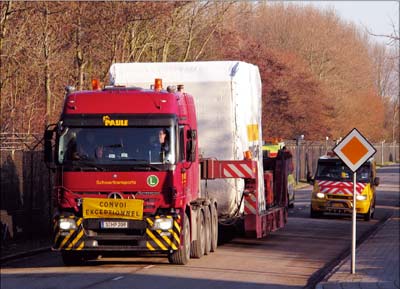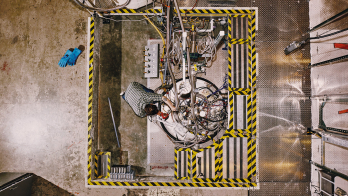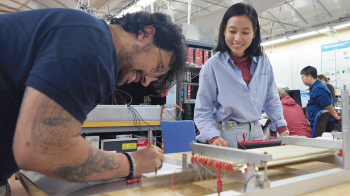
Image credit: ESA/Jari Mäkinen.
The Alpha Magnetic Spectrometer (AMS) left CERN on 12 February on the first leg of its journey to the International Space Station (ISS). The special convoy carrying the experiment arrived four days later at the European Space Agency’s research and technology centre (ESTEC) in the Noordwijk region of the Netherlands, after a journey of 600 km. AMS will then fly to the Kennedy Space Center in Florida before lifting off aboard the space shuttle, probably in July.
With an 8.5-tonne load filled with superfluid helium, this was no ordinary shipment. The AMS detector was inserted into a support structure and surrounded by protective plastic foil before being placed in a box and loaded onto the special vehicle, which also carried a diesel generator running a pump to keep the helium at 2 K. Some 20 members of the AMS collaboration followed the detector on its journey.
The detector components of AMS were constructed by an international team with significant contributions from France, Germany, Italy, Portugal, Spain and Switzerland, as well as from China, China (Taipei) and the US. Assembly then took place at CERN with help from the laboratory’s engineering services.
From 4–9 February, the detector was put through its paces using a test beam from the Super Proton Synchrotron (SPS). The AMS team used protons from the SPS to check the detector’s momentum resolution. It also tested the detector’s ability to distinguish electrons from protons. This is important for the measurement of cosmic rays, 90% of which are protons and constitute a natural background for other signals. The AMS collaboration will be looking for an abundance of positrons and electrons from space, one of the possible markers for dark matter.
The next step in testing has now moved to ESTEC, where ESA’s thermovacuum room simulates the vacuum in space. Here the team will test the detector’s capacity to exchange heat and thus maintain its thermal balance. This is essential to the functioning of the detector’s electronics and superconducting magnet, the first of its kind to be launched into space. If all goes well, towards the end of May the detector will embark on a journey to NASA’s Kennedy Space Center aboard a C5 aircraft owned by the US Air Force. There, it will board the last-but-one flight of the space shuttle Discovery (mission STS-134). Lift-off is scheduled for July.
Once docked to the ISS, AMS will examine fundamental issues about matter and the origin and structure of the universe directly from space. Its central aim is to search for dark matter and antimatter. Its data will be transmitted from the ISS to Houston and on to the detector control centre at CERN, as well as to a number of regional physics-analysis centres that have been set up by the collaborating institutes.








